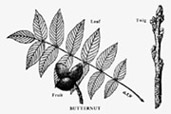Bark - smooth on young trunks and branches, light gray in color; on
older trunks deeply divided into long, broad, flat-topped, whitish ridges.Twigs - stout, brittle,
greenish-gray in color, often hairy, easily identified by a dark-brown furry growth, or
"mustache," found just above most leaf scars; chambered pith dark brown as
contrasted with the light brown chambered pith of the black walnut.
Winter buds -
terminal bud pale, downy, blunt-pointed 1/2 to 3/4 inch long, flattened, longer than wide;
lateral buds smaller and shorter.
Leaves - alternate,
compound, with 11 to 17 practically stemless long-pointed leaflets, margins serrate as in
black walnut; leaves up to 2 1/2 feet in length; leaf stalk, hairy where it joins stem.
Fruit - a rather
large nut, 1 1/2 inches long, tapering at the end, black with fine cut ridges, enclosed in
a sticky, green husk usually in clusters of 3 to 5, ripening in October of the first
season. Kernel - sweet, oily, but somewhat difficult to extract. The butternut has the
advantage of curing without removing the outer husk.
Distinguishing features
- "mustache" above "monkey-faced" leaf scars; dark brown,
chambered pith.
[introduction] [the keys] [list of 50 trees] [making a tree collection]
[back to the homepage]
|
